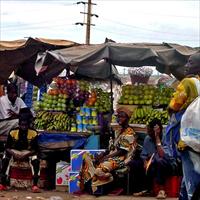SENEGAL: Food insecurity threatens 2.1 million

Up to 2.1 million Senegalese are facing food insecurity linked to high food prices and a poor 2007 harvest, according to an inter-ministerial government assessment.
Over one million face “severe” food insecurity, according to the report’s definitions, and the situation could deteriorate. Senegal has a total population of 11 million.
"The food security and nutrition situation could further deteriorate in the upcoming months if the price rise dynamic does not change,” the report stated. Because of this, “emergency operations must be continued and long-term support to the vulnerable stepped up.”
The study, which was undertaken jointly by the Departments of Agriculture and of Livestock, the Food Security Commission, the National Agency for Statistics, and the government’s early warning centre, covered 485 villages across the country.
Worst-affected
Nine out of ten households in the most-affected regions of Sédhiou, Bignona, Oussouye, have difficulty in covering their food needs over the hungry season, while eight out of ten households face the same problem in Tivaouane and seven out of ten in the regions of Rufisque, Tambacounda and Linguère, according to the report.
The majority of interviewees said while enough food was available in the markets, it was increasingly difficult for them to afford the rising prices.
Indeed agricultural production levels have been dropping over the past few years according to the report, making it “more and more difficult for the population… to satisfy their food needs through their own production.”
The government puts the particularly high number of those in need this year down to a poor 2007 harvest – down by 26 percent on 2006 – because of sporadic, short rains in many parts of the country, as well as floods in the regions of Matam, Kolda and Louaga.
Up to 60 percent of Senegal’s population is rural and depends on subsistence agriculture and livestock-rearing, both of which are highly dependent on good rainfall.
Vulnerability came early
Thierno Ndiaye, livelihoods adviser with non-governmental organisation Oxfam, says the hungry season came early this year, as grain bank stocks started to become depleted as early as February rather than in July which is the usual start to the annual ‘hungry’ season.
“Even by March things were starting to get difficult, and people were already starting to lower the number of meals they ate,” he said. Two out of five households interviewed said they now eat just two meals a day, according to the report.
Government response
The government has reserved US$23.5 million to support rural communities suffering from food deficits and plans to distribute 50,000 mt. of agricultural committees in rural zones over three months, aiming to give 3kg of rice per person.
But, despite publishing its findings, the government has fallen short of declaring an emergency. Three out of ten village chiefs questioned, said they had received food aid from NGOs to help them face their problems.
“If they are reporting severe food insecurity, they have crossed a red line,” said Oxfam’s Ndiaye, “but the government does not want to declare an emergency, and this has stopped NGOs from being able to launch a widespread response.”
Despite this the World Food Programme is working with NGOs to provide food for 30,000 malnourished children under five by September. It aims to reach up to 540,000 people with food aid between September and the end of the year.
Aliou Dia, president of an association of rural agriculturalists says the current government rations are not enough. "They are inadequate. This could relieve hunger for a few days but we need bigger stocks to get through the lean season.” And, he adds, the government needs to get moving if it is to complete distributions by the 20 August as projected.
The ministries involved are calling for increased assistance to be given to the most vulnerable households in the form of food distributions, replenishing village cereal banks, better agricultural training, and where appropriate, school-feeding programmes. They also recommend the situation be regularly monitored through the government’s early warning system.
Hope
The government has already significantly increased its agricultural investments, according to Dia, setting aside US$106 million to the sector in 2008 up from US$58.8 million the year before. So far, this money has been spent on buying and distributing seeds, subsidising fertilisers and pesticides and strengthening rural credit schemes to try to boost production across the country.
This is part of a bigger government-wide push, dubbed the “grand agricultural offensive for food security or ‘GOANA’ to boost Senegal’s self-sufficiency in food production – Senegal currently imports that vast majority of the rice it consumes.
But while some are gung-ho about GOANA, others are more skeptical. An agricultural expert told IRIN when it was launched, “Theoretically it is possible to meet these [rice] targets… but jumping from 20 percent [sufficiency] to 100 percent, given the trend of the past 20 years where yields have been stagnant or even decreased, will certainly be a challenge.”
However, some say the cash injection is already paying off. “The government subsidised seeds by 70 percent this year and they were delivered on time. We hope that if the rains, which started early this year, maintain at this pace, we could even beat past production records,” Dia told IRIN.
And in the meantime, he calls for immediate emergency assistance to be stepped up.
 Back and Next - Back and Next
Back and Next - Back and Next See Also - See Also
See Also - See Also